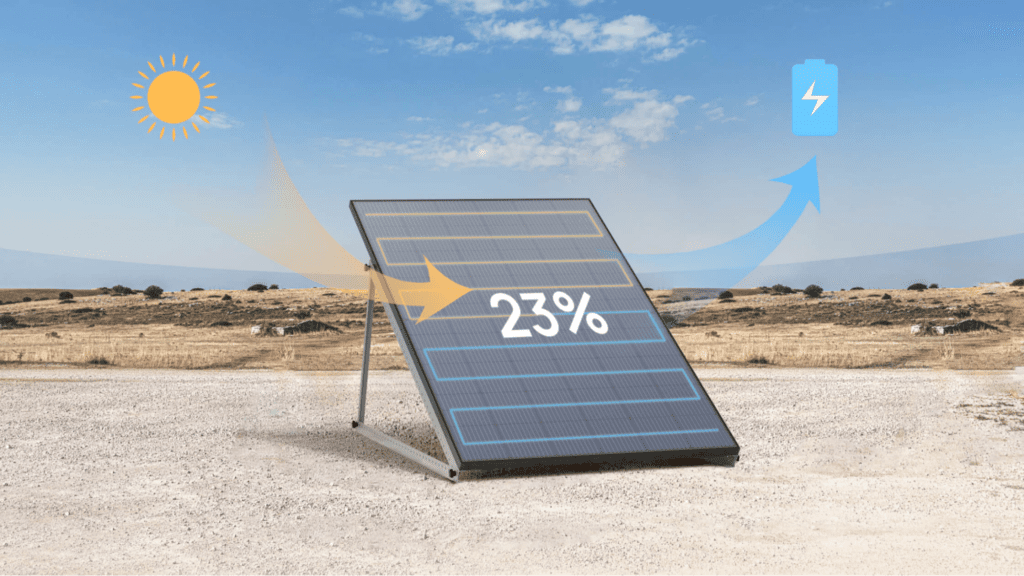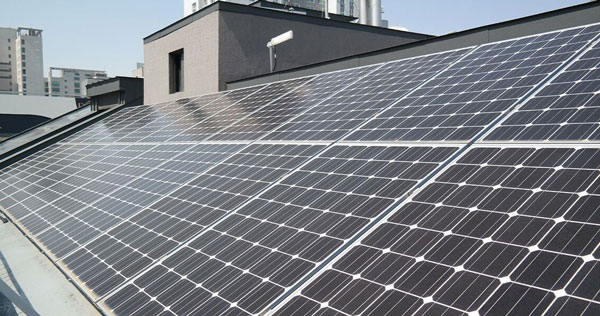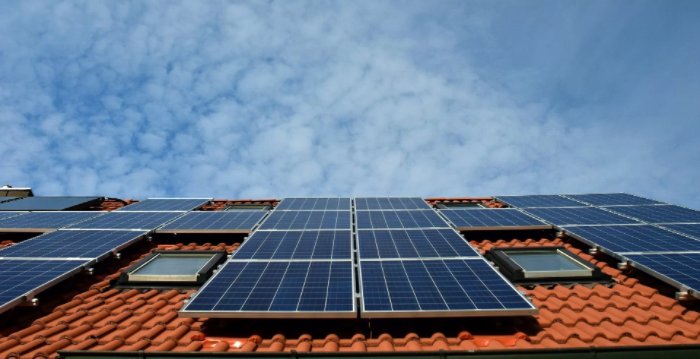Carbon Footprint Reduction
By switching to a 400-watt solar panel, one can greatly reduce the carbon footprint stemming from electrical energy production. To produce electricity, conventional methodology relies on burning fossil fuels, namely coal and natural gas . The generation of electricity through a coal-fired plant results in about 2.2 pounds of carbon dioxide being emitted into the atmosphere per kilowatt-hour . In contrast, solar energy does not result in any direct emissions . Since on average 5 peak sunlight hours are available in the continental United States, to generate about 600 kWh with a 400-watt solar panel. Coal would have emitted about 1,320 pounds of carbon dioxide for 600 kWh, meaning in comparison, solar energy is 1,320 pounds less carbon intensive.
Improving Energy Efficiency
Energy efficiency was also enhanced with a 400-watt solar panel. Indeed, adding roughly a couple of percentages points and presuming much higher thermal pollution is emitted for the manufacturing and shipping of these solar cells along with the transmission of the electrons compared to the energy loss of 5% from the nuclear power plant to electrical outlets, the combined energy efficiency of a 400-watt solar cell combined with transmission would be around the energy efficiency of current nuclear power plants. When electricity is used on-site of production, no losses are taken from the energy reflectively lost during the transportation of electricity for long hours.
Resource Conservation
Solar power varies greatly from the practice of burning fossil fuels, as it preserves natural resources. Specifically, silicon, aluminum and glass are used with the manufacturing of these solar panels, and they are paid back via non-polluting electricity production. Furthermore, a significant advantage of solar panels is their long lifetime, which is estimated to be roughly 25-30 years with minimal maintenance required. They continue to work for long periods without being replaced, which is the crucial advantage over the high turnover of materials when using the fuels that conventional technologies consume. .
Local Environmental Impact
Putting solar panels benefit local environments. Unlike air pollution and the greenhouse gases emitted in the production of electricity, solar power is local. While it is true environmental pollution still occurs during the manufacturing stages of these solar panels, the benefit of not ongoing pollution through the use of fuels is far greater. The land consumed, or rather that cannot be used for other purposes as solar panels are constructed on non-arable lands, is also locally impacted. For instance, in California, these solar panels are installed on rooftops in the cities and the deserts, which do not incur the large-scale land disturbances through mines and exploitation that coal or natural gas require.
Decrease in Air Pollution
Contribution to the reduction of air pollution is an immediate effect of using a 400-watt solar panel since it substitutes the need for fossil fuel-based energy generation. In every kilowatt-hour of solar-generated electricity where coal or natural gas could be used, the reduction in the associated emissions of air pollutants, such as sulfur dioxide and nitrogen oxides , as well as of pollutants carried out by particulate matter . In fact, a single 400-watt solar panel can substitute the energy created by a whole coal-fired plant, despite hundreds of tons of coal being burned every week; therefore, the impact will be significant.
Regular Emission Rates and Calculations
Coal plants are the main emitters of both SO2 and NOx; the chemicals contribute to the formation of acid rains and smog. As reported by the U.S. Environmental Protection Agency , the average SO2 and NOx emissions rates in the United States’ electricity sector in the most recent records that were published were anywhere between 1.314 and 1.271 pounds per megawatt-hour . Consequently, it is manifested that using solar panels can prevent the release of 0.744 pounds of SO2 and 0.786 pounds of NOx into the atmosphere in a span of one year.
Toxic Impacts on Human Health and Natural Ecosystems
The health problems related to human exposure to SO2 and NOx include but are not limited to respiratory illnesses, heart diseases, and even worsened conditions of asthma. However, clean air also contributes to healthier ecosystems: acid rains damage forests and sources of water in rivers and lakes, as well as quickly destroy human-built structures . Therefore, using solar panels to reduce the emission of dangerous substances is beneficial for the environment and the health of the current and future generations.
Examples of Proven Benefits
Solar energy is particularly beneficial in areas where coal is the main source of electricity generation. Hebei, a city in the Beijing-Tianjin-Hebei region of China, invested greatly in solar energy, and the concentration of PM2.5 in the air has decreased as a result.

Conservation of Water Resources
One of the ways that a 400 watt solar panel contributes to water conservation is by saving the water that would have been used in producing or generating traditional power types. At least 161 billion gallons of water are withdrawn daily in the US for use in cooling thermoelectric power plants, and this amount is approximately 39% of all water withdrawn for other purposes . Solar panels do not use any water for generating electricity since they merely draw energy from sunlight. As such, solar power indirectly conserves water by eliminating the need for water dependent energy sources.
It is necessary to note that water is consumed in power generating plants in cooling and processing plays, as well as in boiler systems and other applications. Approximately 85% of power generated in the US depends on steam cycle power plants that require evaporative cooling and other processes that involve water. It is evident from these data that solar panel systems save a significant amount of water that would have been used in generating power. Additionally, in regions with critical water shortages, the conservation effect is more profound. For instance, California, and Nevada are arid regions with minimal water sources, so with solar panels in place, few of this water will be used in power generation.
Solar panels also contribute to water conservation by promoting the stability of regional water sources. In regions with solar panels, the water level in the local water sources does not reduce significantly with the increase in energy generation. Stable water sources can sufficiently support other uses like farming, industrial activities, and other uses. Moreover, when water is not used in power generation, it also promotes relative water peace a contentious water source is bound to cause conflicts. In summary, solar panels promote water conservation by eliminating the need for water in power generation and promoting regional water source stability.
Waste Reduction
The 400-watt solar panel would significantly contribute to the reduction of waste in the energy sector. As such, the bulk of its contribution would be in the reduction of waste in terms of energy production and its consumption.
Lessening By-Products by Fossil Fuels
Traditional ways of generating energy are usually accompanied by harsh by-products of coal, oil, and natural gas . For instance, coal burning could produce around 100 million or more tons of coal ash carrying arsenic, that contaminating both water and soil . Overall, solar energy would circumvent tons of waste that come by producing ash, slag and flue gas desulfurization materials for the burning of fossil fuels.
Durability and Recyclability of Solar Panel
Solar panels have a lasting period of less than 25 to 30 years . The materials used in the production of the solar panel should be taken to an entity that can recycle the glass and the metal frame, which would come as opposed to the excessive waste accumulated from the production of materials unable to be reused and disposed of. The beneficial materials recycled from the solar disc include silver, silicon, aluminum and copper . On the other hand, the glass materials are recycled into other uses, rather than transfilling land.
European Reuse of Solar-Waste
The Waste Electrical and Electronic Equipment or WEEE ensures that countries within the European Union recycle the Solar-Waste in a way that produce no waste by-products. Countries with their forms of recycling strategies include Germany, which has gone ahead to produce recycling technology which can recycle more than 90% of the solar panel . Japan and the United States have also produced technologies of reuse of the solar panelry for reuse.
Promotion of Sustainable Practices
Having a 400-watt solar panel is not just a way to get clean energy but also a way to create the momentum toward a sustainable lifestyle and culture. People, communities, and industries, are encouraged to adopt practices that assure the long-term balance of the ecological systems .
Promoting Green Building Standards
Buildings that take advantage of solar panels and other sources of solar power may reach higher LEED standards . For example, a building that can be potentially self-dependent because of the solar panel system that it introduces may score an enormous amount of points toward the LEED certification, thus stimulating the standards of the green building across the industry .
These standards presuppose that more and more building will be constructed and designed to help to reduce the waste of energy by human communities, to provide for cleaner air, preserve or lead to a reduction of water sources, and solar power is the easiest practical example and means of providing these goals .
Improving Corporate Social Responsibility Score
Companies get to improve their corporate social responsibility image as they adopt the use of solar power and panels. This in turn helps to raise the popularity of business organization and customer loyalty .
There are already a lot of corporate giants like Google or Apple, which use a great portion of solar energy working as renewable energy providers in many cases. They indirectly influence their competitors to follow their example, while placing trust in the hands of consumers while such companies are environmentally responsible. More and more companies get to mitigate wasted energy that they use through the implementation of solar panels .
Community Betterment
Solar panels and power sources are practically implemented across many communities around the United States. These communities are provided with tax rebates, municipal grants, as well as other supplementary means due to which residents and local companies are encourage to start adopting renewable energies invitation. When solar panels are introduced within one municipality, related programs and initiatives are implemented – recycling is extended to suitable means of breathable transportation . For example, the sustainable city projects that many cities like Vermont are implementing presuppose the full usage of renewable sources of energy, solar being one of them.



